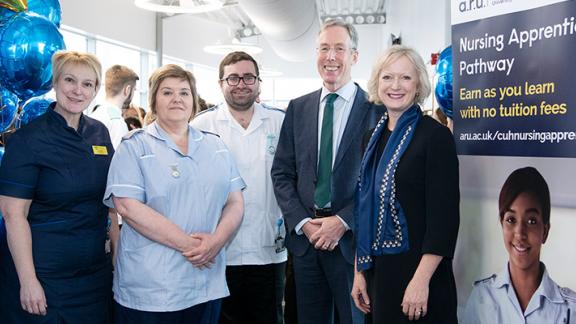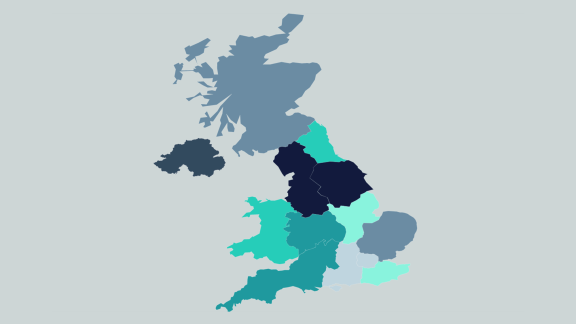Nursing apprenticeship pathway: Cambridge University Hospitals NHS Foundation Trust

Cambridge University Hospitals NHS Foundation Trust (CUH) was one of the first trusts in England to provide a nurse degree apprenticeship pathway at scale and pace. This was achieved through significant trust investment and use of the apprenticeship levy, with the aim to create a pipeline of well-trained and competent staff, loyal to CUH.
What the organisation faced
Like many NHS trusts, CUH has experienced difficulties in recruiting nursing staff. This coupled with high levels of staff turnover resulted in an adult nurse vacancy of 19 per cent (April 2017). It was recognised that this situation was not sustainable and action was required to address the trust’s nurse crisis.
At the same time, the turnover rate for healthcare support assistants (HCAs) was 27.4 per cent and the vacancy rate 31.8 per cent. This highlighted several concerns related to the quality of patient care as well as patient and staff experience.
In response to this, CUH set out to:
- establish a sustainable pipeline of adult nurses including a pipeline of 100 graduate nurse degree apprentices per year by 2020.
- reduce adult nurse vacancy levels to six per cent by March 2020 (19 per cent at its height in April 2017).
- reduce adult nurse agency spend by 20 per cent each year (£70,000 per month in March 2017).
- minimise enhanced pay for adult nurse bank workers (at times 100 per cent premium pay rates were offered) on focused areas for time-limited periods.
- reduce adult nurse turnover by one per cent per annum (14 per cent in April 2017).
What the organisation did
The trust worked with Anglia Ruskin University to develop a pathway which enabled students to gain HCA experience while studying part-time to achieve a nursing degree.
CUH reviewed the options available and decided on the ‘2+2 model’ that allowed a higher apprenticeship (part one) and a ‘top up’ BSc nursing degree (part two). This provided more flexibility, possible step off points and a less expensive model. All those appointed onto the programme are offered permanent HCA posts with a guaranteed registered nurse post upon NMC registration.
Internal and external candidates are interviewed by a dedicated workforce nurse degree apprenticeship team and panels from clinical areas. Both internal and external candidates that have been successful in securing a place on the apprenticeship programme are provided with exposure to the clinical environment in advance of starting the apprenticeship. This is particularly important to external candidates as it gives an insight into working in an acute hospital, observing the skills required to deliver quality patient-centered care and the work-life balance required. It is believed that this exposure process has led to the low attrition rate on the programme.
Part one is a 20-month programme and employees work 30 hours per week as an HCA and 7.5 hours per week on study leave: a combination of their one day at university during term time and one day in practice (supernumerary) when not at university. On completion there is a small break (working full time on their clinical area) before commencing part two.
Part two is a 19-month programme of which 21 weeks is full time block release, with the remaining period working 22.5 hours per week on their home clinical area and 15 hours per week in study (one day at university). During the practice placements they spend time gaining a range of clinical placements including health visiting, community nursing, mental health and maternity.
There are two cohorts each year for both programmes. Existing HCAs were encouraged to apply, and the first cohorts consisted mainly of existing staff. More recently it is a mix of internal and external candidates. External candidates work full-time as an HCA for up to six months before commencing their university place.
As well as developing a sustainable nursing workforce supply, the strategy provides significant career progression opportunities for all age groups and skill levels. Current cohorts’ ages range from 17 to 53 and those with over 12 years of service as a healthcare assistant have successfully graduated through the programme.
The success of the strategy relies on delivering apprenticeships at pace and scale. The trust was able to pay the course fees via the trust’s apprenticeship levy and through additional investment to support backfill costs.
Results and benefits
CUH has seen significant results and benefits from the programme:
- Vacancy rate for adult nurses down to 5.4 per cent.
- Agency spend for adult nurses in financial year 2019/20 is £0.
- Pay enhancements for adult nurses in 2019/20 have reduced by 80 per cent.
- Turnover for adult nurses is nine per cent.
- Attrition from the programmes is very low at 1.9 per cent compared to attrition through traditional university nurse degree programmes, approximately 24 per cent nationally.
- A sustainable and funded pipeline is in place delivering more than 100 nurse degree apprentices each year. In January 2020, CUH had 211 apprentices. This will increase to more than 300 in 2021-22 and recruitment has already started for these cohorts.
The HCA workforce has stabilised as they remain in post for a minimum of four years while undertaking their apprenticeship, ahead of their employment as a registered nurse. Turnover of HCAs has decreased from 19.2 per cent to 8 percent, and the trust expects further reductions.
Staff survey results for HCAs show an improvement to questions relating to access to learning and development. CUH anticipates a year-on-year improvement on turnover and experience as an outcome of introducing the nurse degree apprenticeship pathway.
CUH’s considerable financial and resource investment, including through clinical education support teams, central pastoral support and mentoring has ensured that this pathway is making a positive difference to the working lives of NHS staff; a motivated stable workforce also has an impact on the patient experience. The approach has had the full support of trade union colleagues too.
Overcoming obstacles
There were significant organisational challenges to establishing the apprenticeship pathway, not least the funding to enable staff to be released from rostered clinical activity to attend university and practice placements.
A further challenge was encouraging senior clinical leaders to consider an alternative pathway to nurse training through the new apprenticeship route. There had been a positive culture of encouraging apprenticeships at CUH, but the perception was that these had been aimed at lower academic levels and not suitable for registered professions. It took persuasion and engagement at all levels to demonstrate that the nurse degree apprenticeship had rigour, governance and was supported by the Nursing and Midwifery Council.
Once engaged in the model, the positivity of the clinical areas has been impressive, especially against the backdrop of wards and clinics having to deal with increasing demand for their services while also providing a quality learning environment. Reassurance about central co-ordination and support from corporate nursing and workforce teams was paramount to embed the apprenticeship.
Takeaway tips
- Provide a compelling vision and align with organisational strategy and goals.
- Engage with senior clinical leaders, ward managers, education leads and the extended workforce within the organisation to make the vision a reality.
- Scale and pace are important to gain momentum and commitment.
- Develop a business model that ensures the investment of resources. The trust spent considerable time on this at the outset.
- Board support and commitment to funding backfill costs
- Pastoral support for those new to care and young people is important to have in place
This case study has been developed by NHS Employers as part of an Education and Skills Funding Agency project.



